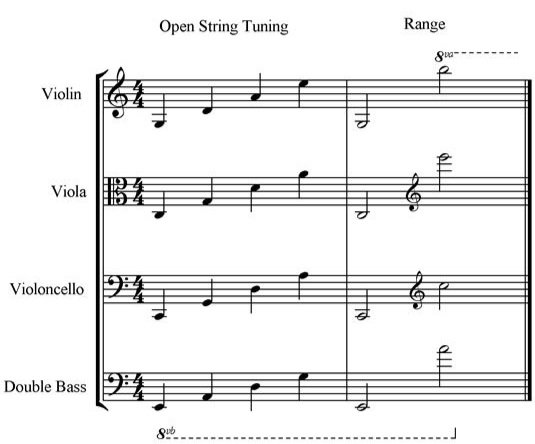Guide to Rating Your Music: Where Range and Grade Level Intersect
In music education, music is assigned a grade level to alert educators of a piece’s difficulty.
As composers and arrangers, you can speak to an educator audience by listing the grade level of your work in your title’s description. This closely follows the easy-intermediate-advanced difficulty range found on ArrangeMe, but shows a deeper consideration for a student’s needs.
One major consideration in grading your music, both vocal and instrumental, is range. Vocalists and instrumentalists expand their ranges with years of practice, and if a piece reaches outside of that range, it may be too difficult to perform.
In choral, orchestral, and band music, grade levels should take every part of the score into account. Rhythmic complexity, dynamic contrast, independent lines, key, meter, and tempo are all among the factors that can determine whether a piece is accessible to its intended performing ensemble.
Publishers and state music education associations assign grade levels to works independently of each other, and there’s no standardized scale. Don’t sweat it! Put yourself in the performer’s shoes. Are you a 4th grade clarinet player or a collegiate violist? Try playing the music yourself, talk to educators, and imagine what might be possible!
Vocal Music
Vocal music may be some of the hardest to fit into a grading scale. In addition to range, you will need to consider how independently each voice part moves, how the vocalists are accompanied, as well as rhythmic and harmonic complexity.
Unlike an instrument, voices change throughout our lives. Grade 1 and 2 choirs may be made up of middle school students whose ranges are not fully realized, and whose voices might change within the rehearsal period of a single piece.
A vocalist’s most comfortable range, and the range of beginners in each voice type, will fall in the middle of the ranges notated in the chart below.
Additionally, factors like dynamics and vowel shaping will affect how notes sound at different points within the listed ranges. A soprano’s control over their high B-natural (B5) may be less consistent than their A4.
This guide for grading vocal music closely follow’s ArrangeMe’s difficulty rating:
Grade 1: Easy/Beginner
Works in unison to 2 parts, containing simple rhythms and harmonies, often with supportive keyboard accompaniments. Choirs at this level have limited note-reading skill.
Grade 2: Easy/Intermediate
Works in up to 4 parts, mostly with easy rhythms and harmonies and helpful keyboard accompaniments.
Grade 3: Intermediate
Works in up to 4 parts, containing some challenging passages, with or without accompaniment.
Grade 4: Advanced Intermediate
Works in any scoring, with or without accompaniment, and containing some challenging passages. These works require solid reading skills and independence from singers.
Grade 5: Advanced
Aimed at selective and professional choirs, these works are both technically and musically challenging.
Based on descriptions found at alansimmonsmusic.com.
Below is the approximate vocal range of each voice type in choral music.
Image source and more information on vocal ranges by James Mann at becomesingers.com.
Instrumental Music
Grade level is influenced by range, but in instrumental ensembles it is also influenced by player independence, key, duration, rhythmic complexity, and more. Unlike vocal range which is determined in large part by the physical anatomy of the voice, instrumental range is primarily determined by the instrument itself, and how much practice one has on the instrument.
Each instrument will have its trouble spots, but a major development occurs in string instruments when students learn to shift positions. A similar development occurs when clarinets learn to cross the break. Brass instruments, particularly the trumpet, need time to develop the embouchure required to reach higher into their range. If these concepts are new to you, never fear! Follow the links we included, and invest some time into researching player development so that students can play the music you write.
Keep in mind that the orchestra’s most comfortable keys are sharp, while the concert band’s most comfortable keys are flat.
Hal Leonard describes the grade levels below, and we’ve expanded their guide for you here:
Grade 1: Very Easy
ArrangeMe equivalent : “Easy/Beginner”
One year of playing experience. Limit instrument range to one octave at most, and group like instruments in unison. Orchestras are most comfortable in the key of D, and bands are most comfortable in B-flat. The first five notes in these keys will be the most comfortable at this level.
Grade 2: Easy
ArrangeMe equivalent: “Easy/Intermediate”
Two years of playing experience. String and woodwind instrument range increases, brass range is still developing. Easy syncopation and key changes. Individual instrument types break off from the group for solo and soli lines.
Grade 3: Medium
ArrangeMe equivalent: “Intermediate”
At least three to four years playing experience. No more than five sharps for orchestra and five flats for band. Harmonic complexity and rhythmic complexity in large groups are welcome.
Grade 4: Medium Advanced
ArrangeMe equivalent: “Advanced Intermediate”
Standard repertoire for high school ensembles. Full instrument range may be used, but be cautious at the extreme highs and lows. Full dynamic contrast, asymmetrical meter, and exposed scoring are welcome. A piece’s duration may extend beyond 6 minutes at a minimum.
Grade 5: Advanced
ArrangeMe equivalent: “Advanced”
Any meter and key is fair game for both orchestras and bands. Any limits will depend on player ability.
Grade 6: Very Advanced
ArrangeMe equivalent: “Advanced”
Music for collegiate and professional ensembles.
Instrument Range Charts
Below are the full standard ranges of the four orchestral string instruments.
For more information on each individual instrument, their ranges and abilities, as well as information on the orchestral wind and percussion instruments, visit the Philharmonia website’s instrument guide.
Image source and more stringed instrument information here.
For band composers, bandworld.com offers the incredibly helpful American Band College Music Grading Chart, which outlines ranges by grade, as well as considerations for key, rhythm, notation, and more.


